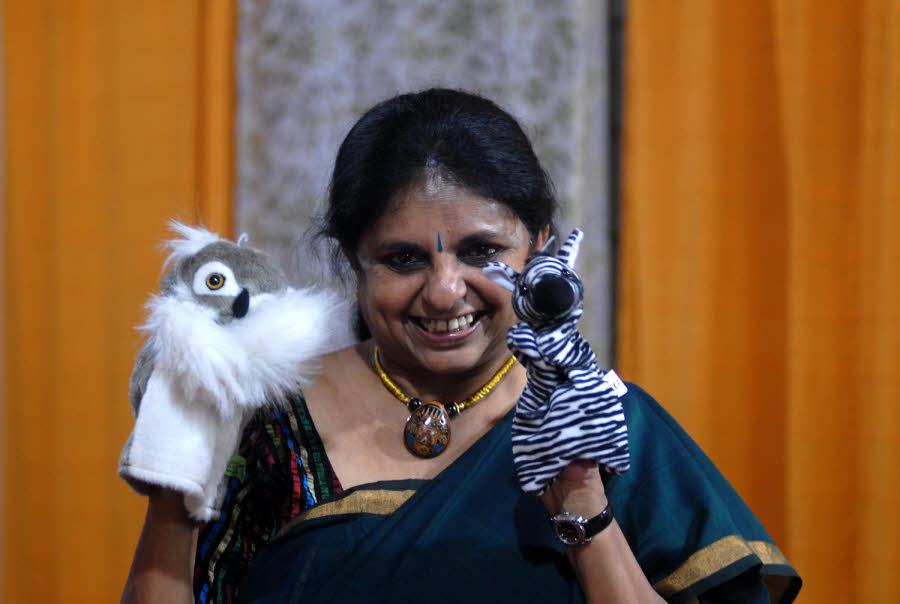Geeta Ramanujam, a recipient of the Ashoka Fellowship, Washington, USA, is the Founder Trustee and Executive Director of Kathalaya Trust, a centre established with the intention of reviving the ancient art of storytelling and using it in schools as a cultural tool in education. Kathalaya does storytelling sessions and workshops for schools as well as empowerment programmes for teachers. Kathalaya’s Academy of Storytelling, which is affiliated to International Storytelling Centre, Jonesborough, Tennessee, USA, has two centers in India: one each in Bangalore and Chennai, and offers short-term and long-term certificate courses in storytelling. In this interview, she talks about how she began using stories as a teaching aid and why stories are very relevant in education and de-stressing.
How did you hit upon this idea of using stories as a teaching aid?
One fine morning I entered the school where I taught, with a new innovative methodology and curriculum for Social Studies – History and Geography, for classes four to eight. I had worked through the summer to create the methodology – a concept based on experiential learning, research and reference projects and historical tours. The background of it all was joyous learning and stories. This was at the Krishnamurti Foundation School in Bangalore. That very day, I was asked to take charge of the library. I was an avid reader but had no background of library management. It was a sudden change and shift from a noisy classroom of five hours of teaching to a silent place in the library.
I soon realized that children were not reading and began to tell them stories from the books in the shelves, combined with the stories of authors, poets, artists and characters. Soon, I chose spots within the campus to read out tales like Jataka and Panchatantra, near the lakes, pottery shed, language room, and in the art shed. Then, the children began to make clay models of the characters and used words to develop language skills or painted the colours and the mountains of the story in the art room.
Why do you think stories are an important aspect of learning?
There are many reasons. Storytelling as an educational tool promotes an interactive and interesting teaching-learning ambience. Stories help improve attention span of children and promote better involvement and participation. They generate better interest and conceptual understanding of topics of study. Story telling also facilitates creativity in the teacher, breaking the monotony of daily class room teaching. It kindles creative imagination in children.
Storytelling is an innovative and creative way to teach. Learning becomes easier if it’s fun. Schools today place emphasis on Intelligence Quotient and not on Emotional Quotient, little realizing that overall development in terms of sport and art and honing talent are as important and as essential as academics.
Storytelling has its own merits. A walk down the annals of history shows that the finest educators resorted to storytelling to put across their concepts. The famous Panchatantra is nothing but a collection of stories meant to give wholesome education.
What sort of lessons do you impart using stories? Can you give us a bird’s eye view?
Here is an example of what we teach using our stories.
Let’s take this story that has been adapted from Akbar and Birbal Stories:
Just One question
One day a scholar came to the court of Emperor Akbar and challenged Birbal to answer his questions and thus prove that he was as clever as people said he was. He asked Birbal, “Would you prefer to answer 100 easy questions or just a single difficult one?” Both the Emperor and Birbal had had a difficult day and were impatient to leave.
“Ask me one difficult question,” said Birbal. “Well then, tell me,” said the man. “Which came first into the world, the chicken or the egg?”
“The chicken,” replied Birbal.
“How do you know?” asked the scholar, a note of triumph in his voice.
“We agreed to ask only one question and you have already asked it,” said Birbal, and he and the Emperor walked away leaving the scholar gaping.
This is a model of my Lesson Plan.
Story Title:
Just One Question
Aim of the Story:
To Teach History
Subject Links:
History – Mughal period
Standard/Level:
Middle
Story Aids:
Tell the story wearing a costume or cloak.
Fact File:
Great Kings had wise advisors, Koutilya in the court of Chandra Gupta Maurya, Tenali Rama of Krishna Deva Raya’s court and Birbal of Akbar’s court.
Follow-up Activity:
Read other Akbar, Birbal, Tenali Rama stories
Stories for children is something we are familiar with. What about the grown-ups? We understand you do workshops for them too. If yes, what do you focus on in such workshops?
Several methods of relaxation and de-stressing have been tested and tried but only few methods have stood the test of time. Yoga and Meditation are our very own culturally-acclaimed and traditionally-accepted techniques which are logically recommended by experience and evidence today.
Another medium which is emerging as a powerful tool in de-stressing and promoting positive emotions is listening to stories. Storytelling is as old as seas. Stories can be magical and have the power to promote positive thinking in listeners.
How exactly do you narrate stories? Do tell us what tools you use to add that element of ‘interest’ in storytelling sessions.
Before I tell a story, I prepare it in my mind thoroughly. I tell it aloud several times with action, voice, expression, timing and any props, which I rarely use for the story. Then, I polish the story well, in terms of language, clarity, tone etc. When I tell the story, I take care to keep the audience in mind – their age, energy and background. I also see that my emotions, telling and my eye contact are well received by the audience. After the storytelling session, I have found that most of the audience feel emotionally touched and children fully concentrate with their heart and soul.
